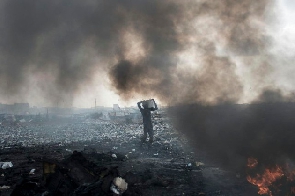The Environmental Protection Agency (EPA) is jointly conducting a research at Jamestown in Accra with the United States (US) Embassy and an NGO, Environment 360, to measure the degree of pollution in the area.
Mr. Emmanuel Appoh, the Head of Environmental Quality Department of the EPA), said the outcome of the research would enable the Agency to determine the sources of air pollutants and take appropriate action to deal with these to improve the air quality.
Jamestown, a predominantly fishing community, was chosen for a case study because of the intense use of firewood for fish smoking.
Mr. Appoh was speaking at an air quality event held by the US Embassy for journalists in Ghana’s capital city of Accra, on Thursday.
The goal was to aid them to have better understanding of the threats of air pollution in the country and the West African sub-region.
The EPA official spoke of steps taken to install air monitors to assist the Agency to collect accurate data to forecast possible threats.
Two regulatory grade monitors, the unit cost is about US$160,000, are going to be installed at the University of Ghana Campus and Adabraka, by June, to aid both data collection and policy formulation.
Each monitor would cover a four-kilometre radius and that would enable the EPA to provide information on day-to-day reading of the Air Quality Index and forecast to the population.
The installation of the equipment, he said, was being done with the support of the World Bank.
He said it was in everybody’s interest to join the effort at reducing air pollution because of its harmful effects on human health.
“Air pollution does not know anybody and must be given serious attention by all”, he added.
Dr. Daniel Westervelt, US EPA Air Quality Fellow, said bridging the data gap within the country and the sub-Saharan region was crucial in the fight against air pollution.
He suggested that calibrated low-cost air quality monitors such as ‘Purple Air Sensors” could be installed in addition to the regulatory grade monitors to aid in data collection across the country.
He underlined the need to provide the people with access to data on air pollution to empower them to take action.
He advised that air pollution solutions should be co-produced by U.S and African leadership and cited how the New York City, in the 1950s and 1960s, was saddled with air pollution challenge but through many interventions, the situation had significantly improved.
Health News of Friday, 21 February 2020
Source: GNA

















